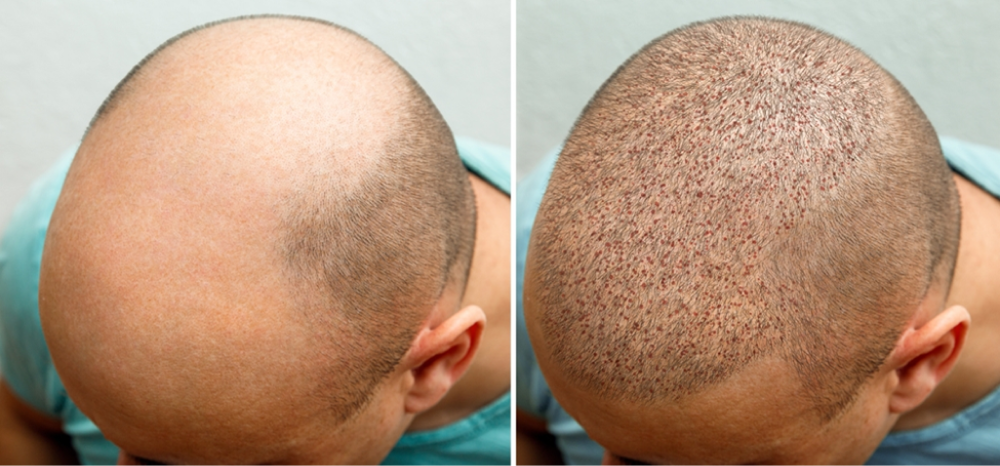If you are disappointed with your substandard hair transplant when you look in the mirror, your first question is probably whether it’s possible to improve it. The answer is yes, in the hands of the right practitioner. It takes an accomplished surgeon with a high degree of skill with advanced techniques to improve a subpar hair transplant, and Oakville-based hair loss physicians Dr. Jonathan Huber and Dr. Ashlin Alexander are the leading choice.
Understanding the Hair Transplant Process
Before delving into the corrective aspects, it is crucial to understand the hair transplant process itself. Hair transplant surgeries involve the extraction of hair follicles from areas of the scalp with healthy hair growth, known as the donor site, and transplanting them into areas with thinning or no hair, known as the recipient site. This process is typically performed under local anesthesia, and the two most commonly used techniques are follicular unit transplantation (FUT) and follicular unit excision (FUE).
During FUT, a strip of scalp is surgically removed from the donor site, and the hair follicles are extracted from this strip. On the other hand, FUE involves extracting individual hair follicles directly from the donor site using a specialized tool. Both techniques have their advantages and considerations, and it is essential to consult with a skilled hair transplant surgeon to determine the most suitable option for each individual’s unique circumstances.
Hair Transplant Before and After: What to Expect
It is crucial to manage expectations regarding the outcome of a hair transplant surgery. While the primary goal is to achieve natural-looking hair growth, it is essential to understand that the transplanted hair initially falls out before undergoing a regrowth phase. This temporary shedding can occur within the first few weeks after the procedure and is a normal part of the hair transplant process.
After this initial shedding, new hair growth typically begins within a few months, with significant improvements visible after six to nine months. However, the complete results may take up to a year to become fully evident. It is important to note that individual results may vary, and factors such as the extent of hair loss, the quality of the donor hair, and the skill of the surgeon can influence the final outcome.
Hair Transplant Revision Surgery
As a pioneering hair transplant surgeon in Toronto, Ontario, Dr. Robert Jones opened the Toronto Hair Transplant Surgeons centre and although he has since retired, Dr. Jones left his partners, Drs Huber and Alexander positioned to help patients from all over the world get outstanding results, including men and women who are dissatisfied with previous hair transplants that didn’t go as well as they’d hoped.
Inadequate coverage, unnatural appearance of transplanted hairs and prominent strip scars are just a few of the things that may have left you less than thrilled with your poor hair transplant. Our doctors will work with you to take your unique needs into account and provide you with the natural look you anticipated.
Reasons to Seek Hair Transplant Revision
Dr’s Huber and Alexander regularly work with patients who have come from as far away as Australia seeking follow-up hair transplant surgery. Though the decision to get hair restoration surgery is intensely personal, here are some common reasons people come to the Toronto Hair Transplant Surgeons for their revision surgery:
-
To improve upon antiquated methods:
Hair transplant technology has come a long way in the past few decades. Older techniques such as the “hair plug” method now look outdated and artificial, and many patients who underwent these surgeries long ago now desire corrective surgery to improve their hairline with a more natural look and feel.
-
To conceal strip scarring:
Another common reason people pursue hair transplant revision surgery is to hide the unsightly scar leftover from the “strip” method of hair restoration. Though it is still a relatively common practice to harvest hair grafts in a long strip taken from the back of the scalp, this method leaves patients with a long, linear scar that can sometimes be quite prominent, thus detracting from their results and making it more obvious that they had hair surgery.
-
To address further balding:
Since hair loss is also a progressive condition, even a patient who was happy with their original hair transplantation may find themselves wanting an additional surgery several years down the road when their advancing hair loss causes their coverage to look patchier.
FUE for Hair Restoration Revision
Follicular unit excision, or FUE, is widely known as the “gold standard” of hair restoration surgery because it allows a precise degree of control over the placement of individual hair grafts while leaving patients with virtually undetectable scars after their donor sites heal. Because it doesn’t involve any incisions or sutures, this outpatient surgery also has a relatively quick and painless recovery time, making it ideal for men and women with busy lifestyles.
Dr. Jones was one of the first hair restoration physicians to specialize in this groundbreaking technique, and today both Dr. Huber and Dr. Alexander routinely perform FUE procedures with as many as 3,5000 separate grafts in a single-day session. Care is taken to place each graft so it will grow in the correct direction, thus ensuring the results look completely natural.
Because FUE represents the current pinnacle of what hair restoration surgery can achieve, it is an ideal technique for improving uneven coverage and correcting unnatural-looking results leftover from previous hair loss surgeries. In some cases, our doctors may be able to graft hair follicles into a scar left behind from strip surgery to help hide it. However, the grafts may not take root as successfully in scarred skin as they do in unmarred tissue. The doctor will be able to tell you your options for concealing scarring when you meet during your consultation.
Who Is Qualified for Hair Transplant Revision Surgery?
Ideal candidates for hair transplant revision are people in good overall physical health whose previous hair restoration surgery left them with aesthetic complaints or cosmetic complications. Before undergoing a revision, it is essential to have realistic expectations about what your procedure will entail. Communicate your goals to Dr. Huber or Dr. Alexander in advance and ask any questions you need to make sure you understand the FUE transplant timeline.
How Does Hair Revision Surgery Work?
Our doctors at Toronto Hair Transplant Surgeons take a customized approach to hair restoration, taking your appearance and personal style into account. In general, a carefully planned revision surgery will entail camouflaging sparse coverage with the modern FUE technique, transplanting the donor follicles in a way that will yield the most natural-looking results possible. Our highly skilled surgeons, Dr. Huber and Dr. Alexander will use their high attention to detail to improve hair density, and can even improve the angle of your hairline.
You will be able to go home the same day of your procedure, and can even return to work the following day if you so choose, though many people decide to take a day or two off to rest at home. Significantly shortened recovery time is another benefit of the FUE process. For most patients, the grafts become fully secure in about eight days after surgery, and the small surgical wounds in the donor area usually heal within one to two weeks.
Depending on your concerns and what you hope to accomplish with your hair transplant, you may require more than one session to achieve your desired results, though the improvement can be quite dramatic after only one procedure in many cases. Patients who have undergone hair transplant revision at Toronto Hair Transplant Surgeons often note a marked increase in self-confidence after they begin to enjoy their full, naturally growing head of healthy hair.
FAQs
Can hair transplant surgeries be performed on women?
Yes, hair transplant surgeries can be performed on both men and women. However, the causes and patterns of hair loss surgeries may differ between genders, and a thorough evaluation is necessary to determine the most suitable approach.
Are hair transplant surgeries painful?
Hair transplant surgeries are typically performed under local anesthesia, ensuring that the procedure is relatively painless. Some individuals may experience mild discomfort during the recovery period, which can be managed with prescribed pain medication.
Will the transplanted hair look natural?
The goal of hair transplant surgeries is to achieve natural-looking results. By strategically placing the transplanted hair and mimicking the natural hair growth pattern, skilled surgeons can ensure that the final outcome appears seamless and undetectable.
Are the results of hair transplant surgeries permanent?
Yes, hair transplant surgeries offer a permanent solution for hair loss. The transplanted hair follicles are resistant to the hormone responsible for hair loss, ensuring that the newly grown hair remains in place.
When can one resume regular activities after a hair transplant surgery?
The recovery period varies among individuals, but most individuals can resume regular activities within a week or two after the surgery. Strenuous physical activities and excessive sun exposure should be avoided for a few weeks to allow for proper healing.
Get More out of Life With a Hair Transplant Revision
If you have experienced less-than-stellar results from a previous hair transplant, you don’t have to remain dissatisfied. Contact Toronto Hair Transplant Surgeons to schedule a no-cost, no-obligation consultation. During this initial conversation, Dr. Huber or Dr. Alexander will perform a thorough evaluation of your hair-related issues and talk with you about your concerns. Together, you can come up with a new plan for addressing the disappointing or unnatural-looking outcome your previous hair restoration surgery left behind. You have options for making it right.











